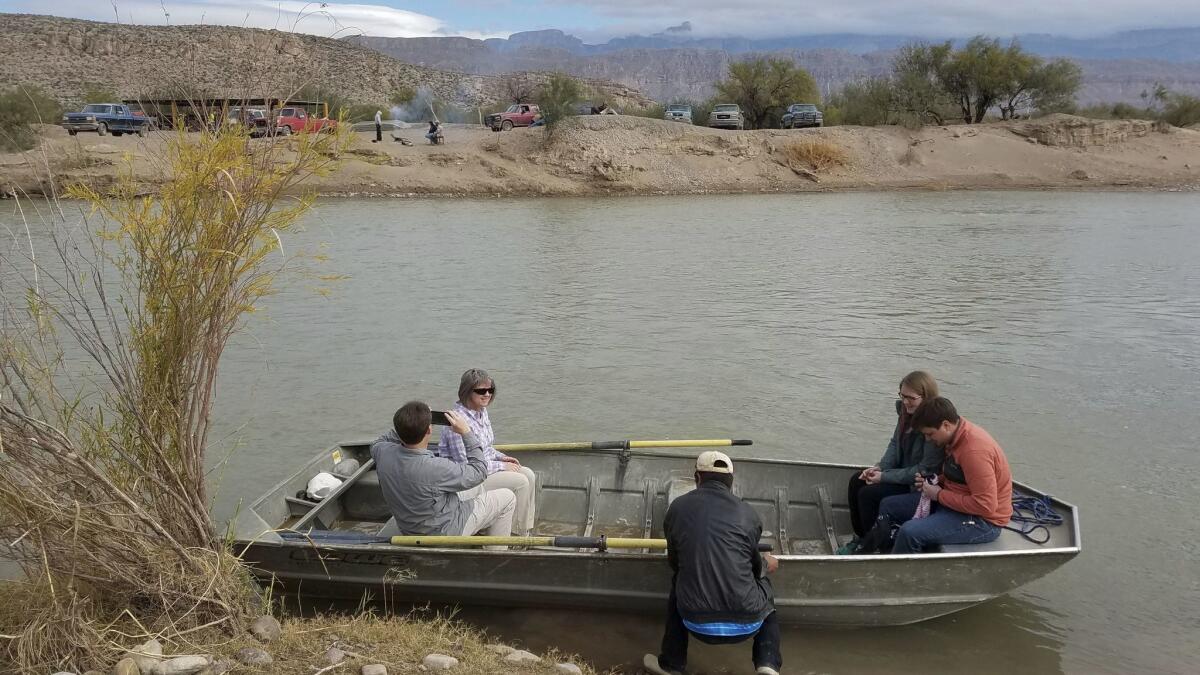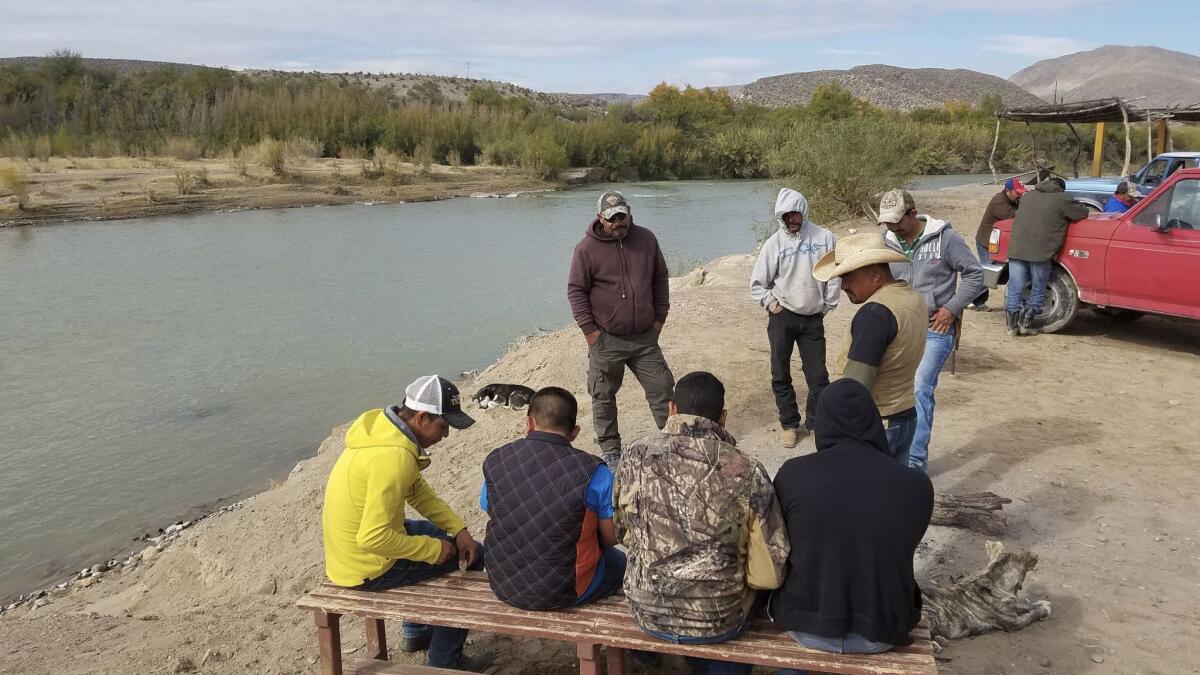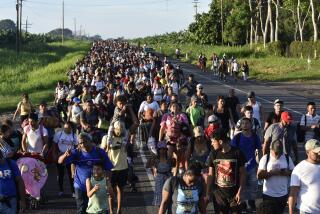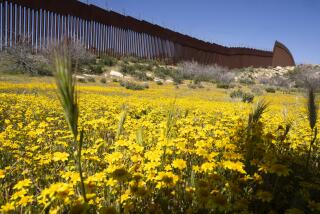At a remote Texas border crossing, pleas for ‘No wall’

At this remote border crossing in Big Bend National Park, the loudest sound is the babbling Rio Grande. Amid lush green stands of cane a ferryman waits to row tourists across the river in a battered metal dinghy.
The U.S. government closed Las Boquillas (“little mouths” in Spanish) border station after the Sept. 11 terrorist attacks. It reopened in 2013 with two automated kiosks and a lone U.S. Customs and Border Protection agent. No wall was ever built.
The crossing has become popular with U.S. tourists who want to visit the tiny Mexican town of Boquillas del Carmen. From the border station, a dirt path leads through a patch of cottonwood trees to the sandy riverbank.
In the shadow of the Sierra del Carmen mountains, Melissa Epperson picked her way toward the rowboat Saturday with her husband, Hal, a county judge back in Kissimmee, Fla. It was their first trip to the park for the couple, both in their early 50s.
She was nervous about crossing. “It’s the unknown,” she said.
But he was grinning, excited.
“I’ve never been to Mexico, so this was my chance,” he said as they prepared to board.
A younger couple followed them to the boat, toting cameras.
The ferryman, Carmelo Sandoval, who wore cowboy boots and a silver cross, ushered the group aboard. It took him just a few minutes to row across the green, swirling river.

During the winter holidays, Carmelo Sandoval rows hundreds of tourists across the Rio Grande from southwest Texas to the Mexican town of Boquillas del Carmen. The remote crossing in Big Bend National Park is within the largest U.S. Customs and Borde
Sandoval, 40, has been working the crossing for five years, and said business has been good: 300 people crossed daily during Thanksgiving, and he expected at least 200 a day during the winter holidays.
Although some visitors worried about security — border agents have caught drug smugglers in the vicinity, and a Border Patrol agent was killed last month about 200 miles north off Interstate 10 in an attack the FBI is still investigating — Sandoval said things have been peaceful lately.
He pointed at the thick brush on the U.S. side and described the limits of the security measures: “Nothing more than cameras.”
On the Mexican side, Sandoval helped the couples off of his boat and up a dusty hill where a dozen men huddled around the remains of a mesquite fire. Some had migrated from as far south as the Guatemalan border to work the crossing, hoping for tips. They hawked $5 rides into town by truck or burro.

Most tourists prefer to walk — it’s only a mile — to sample spicy red enchiladas at Falcons, and tequila and Carta Blanca beer at the Park Bar. None of that is legal to bring back to the U.S. Instead, they haul home handmade souvenirs, wire-and-bead sculptures of roadrunners and creosote bushes.
These days, locals are also selling T-shirts and handkerchiefs embroidered with a message in English protesting President Trump’s vows to improve security with a massive construction project: “No wall.”
Some visitors said there was already too much security.
Paul Dryer, a financial planner who lives near Dallas, first traveled south to the “cowboy town” of Boquillas del Carmen in 1974. Back then, there was no Border Patrol checkpoint. He and his friends used to hike or swim across the river to strum guitars at the Park Bar.
This was the Boquillas that Texas country singer Robert Earl Keen extolled in his 1994 song “Gringo Honeymoon”:
Tied our donkeys to an ironwood tree,
By the street where the children play,
We walked in the first place we could see,
Servin’ cold beer in the shade.
On this visit, Dryer and his family checked in with the agent at the gate, then took turns scanning their passports at one of the kiosks, an agent working remotely from El Paso — 275 miles west — giving them final clearance.
“The vibe is not the same,” Dryer said ruefully. “The town’s not the same: Not as laid back, a lot more souvenirs for sale. You see all those guys with the burros? They’re just waiting. When you see that many guys waiting for $5, they’re hurting.”
Dryer, 62, was at the crossing a couple of days after the Sept. 11 attacks when it closed and the region fell quiet.
He remembered how the town was cut off afterward, when churches sent food and other relief. Tourism plummeted. Even regulars like Dryer stopped going. This was his first visit in 16 years. His group bought an orange “No wall” T-shirt and one of the embroidered handkerchiefs.
“If there was a wall between it and the U.S., that town would die,” he said.
At the Border Patrol station, visitors from as far as Australia and Japan praised the little town in a guest book and Americans registered their opposition to erecting any kind of barrier.
Alex Magallan, 33, a firefighter and paramedic from Houston, walked back to the boat with a bag full of souvenirs for his older sister Sandy and her 6-year-old son, who were waiting in the car back on the U.S. side. They had come to camp in the park, but forgot passports and birth certificates and couldn’t cross.
The siblings grew up to the east in the Rio Grande Valley, where drug-related violence on the Mexican side of the border has decimated tourism. Only a few tourist crossings remain, and they are either remote, like the hand-drawn ferry at Los Ebanos, or commercial, like the Progreso crossing flanked by pharmacies and dentists catering to retirees.
Magallan was nervous when he first crossed to remote Boquillas. But then he saw other tourists and relaxed.
The town reminded him of the landscape of his childhood. He chatted with locals in Spanish about living with limited water and electricity.
The border crossing is only open from 8 a.m. to 5 p.m., so by afternoon he had to leave. They urged him to return and rent a burro to visit a cave nearby.
His sister was intrigued.
Did he try the enchiladas, she asked? No, tacos.
How were the tortillas, she wanted to know. Possibly a mix of flour and corn, he said.
Did people speak a different Spanish dialect?
“You should go next time!” Magallan said, drawing a smile from his sister.
“I will.”
To read the article in Spanish, click here
molly.hennessy-fiske@latimes.com
More to Read
Sign up for Essential California
The most important California stories and recommendations in your inbox every morning.
You may occasionally receive promotional content from the Los Angeles Times.











